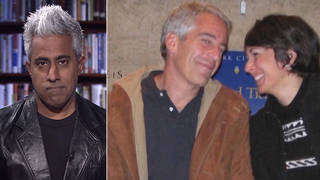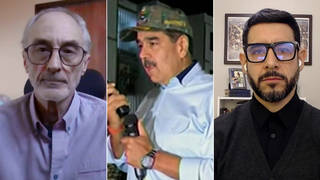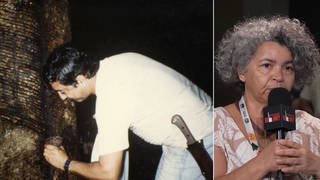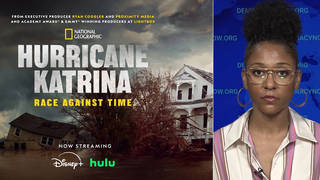
Topics
Guests
- John McQuaidPulitzer Prize-winning reporter. In 2002, he co-authored a series in the New Orleans Times-Picayune, where he’d worked for more than 20 years, that predicted the fate that would befall New Orleans three years later. He has just published a three-part investigative series on the Mother Jones website titled “Storm Warning.” He is co-author of the book, Path of Destruction: The Devastation of New Orleans and the Coming Age of Superstorms.
Links
Today marks the second anniversary of Hurricane Katrina. The storm ravaged the Gulf Coast of Louisiana, Mississippi and Alabama, and left over 1,600 people dead. More than 300,000 homes were destroyed, and over 770,000 people displaced. It was the most powerful and expensive natural disaster to hit the country and one of the deadliest hurricanes recorded in U.S. history. We speak with Pulitzer Prize-winning reporter, John McQuaid. [includes rush transcript]
Transcript
JUAN GONZALEZ: Today marks the second anniversary of Hurricane Katrina. The storm made landfall south of New Orleans at 6:10 a.m. on August 29, 2005. The powerful hurricane ravaged the Gulf Coast of Louisiana, Mississippi and Alabama, and left over 1,600 people dead. More than 300,000 homes were destroyed, and over 770,000 people displaced. It was the most powerful and expensive natural disaster to hit the country and one of the deadliest hurricanes in U.S. history. Eighty percent of New Orleans was submerged underwater after the storm surge caused several breaches in the city’s levees.
In the aftermath of the hurricane, the federal government was nowhere to be found.
Images of the New Orleans residents piling into the Superdome and Convention Center pleading for food, water and aid were broadcast around the world.
AMY GOODMAN: We go back now two years ago to remember some of Democracy Now!’s coverage of Hurricane Katrina. This is New Orleans Mayor Ray Nagin.
MAYOR RAY NAGIN: Ladies and gentlemen, I wish I had better news for you, but we are facing a storm that most of us have feared. Every person is hereby ordered to immediately evacuate the city of New Orleans, or, if no other alternative is available, to immediately move to one of the facilities within the city that will be designated as a refuge of last resort.
AMY GOODMAN: New Orleans and the Gulf Coast region remain in a state of catastrophe following the devastating Hurricane Katrina. At least 80 percent of New Orleans is underwater. The city has no electricity and little drinkable water. Officials say New Orleans will be uninhabitable for weeks. On Tuesday, two levees broke, flooding areas of the city that had appeared to survive the storm.
MAYOR RAY NAGIN: This is a national disaster. Get every doggone Greyhound bus line in the country and get their asses moving to New Orleans. That’s — they’re thinking small, man, and this is a major, major, major deal.
BILL QUIGLEY: You are talking about tens of thousands of people who are left behind, and those are the sickest, the oldest, poorest, the youngest, the people with disabilities and the like, and the plan was that everybody should leave. Well, you can’t leave if you’re in a hospital. You can’t leave if you’re a nurse. You can’t leave if you are a patient. You can’t leave if you’re in a nursing home. You can’t leave if you don’t have a car.
CROWD: Help! Help! Help! Help!
JUAN GONZALEZ: To commemorate the second anniversary of Hurricane Katrina, protesters plan to march today from the Lower Ninth Ward to Congo Square to spread their message that after two years the government has failed to help people return to their city.
The anniversary has attracted a slew of politicians to New Orleans, chief among them President Bush, who arrived in the city with Laura Bush Tuesday night. The president is scheduled to make a televised address there later today.
Meanwhile, an international people’s tribunal has been convened in New Orleans to take testimony from victims of the disaster. The tribunal is being spearheaded by legal activists trying to build a case under international law accusing the U.S. government of human rights abuses during and after Katrina.
AMY GOODMAN: John McQuaid is a Pulitzer Prize-winning reporter. In 2002, he co-authored a series in the New Orleans Times-Picayune, where he had worked for more than 20 years, that predicted the fate that would befall New Orleans three years later. He has just published a three-part investigative series in Mother Jones magazine called “Storm Warning,” and he’s co-author of the book, Path of Destruction: The Devastation of New Orleans and the Coming Age of Superstorms. John McQuaid joins us now from Washington, D.C. Welcome to Democracy Now!, John.
JOHN McQUAID: Good morning.
AMY GOODMAN: Can you talk about what you understood three years before Katrina hit, what it meant for what actually happened and what it means for today?
JOHN McQUAID: Well, it was common knowledge in the disaster management community that New Orleans was incredibly vulnerable to a large hurricane, and my co-author and I looked at that issue. We looked at the levee system and specifically weaknesses in the levee system. Was the Corps of Engineers really telling us the truth when it said we were well protected? We concluded that it was not. And, in fact, it turned out that things were far worse than even we had anticipated, because there were actually flaws, engineering flaws, in the levee system that caused walls to collapse prematurely and flooded vast areas of the city that otherwise would not have flooded.
JUAN GONZALEZ: You talk in your series of articles about what has happened since then and the promises to rebuild the protection for New Orleans from the federal government. What has happened?
JOHN McQUAID: Well, the Corps — after Katrina, the Corps pumped the water out of the city and then immediately turned around and started repairing the levees, designing fixes for where the holes were, and rebuilding. And over the last two years, they have repaired the levees, and they are now trying to upgrade the system so that it’s — there’s a standard level of protection everywhere, because before, depending on where you were, it was variable how much risk you faced.
However, all of this is basically a giant stopgap. The level of protection that they’re providing, which is a one-in-a-hundred-year event protection, is really not strong enough. It wouldn’t have protected against Katrina, for example. It’s not strong enough to protect the city over the long run. And so, the Corps is also studying how to do that. But right now there is no master plan on how to do that, and it’s going to be very costly. And frankly, I’m not sure that we have the resources and the institutional moxie in place to be able to do that.
JUAN GONZALEZ: And when you talk about depending on where you were in New Orleans, the kind of protection you had, how does that correlate to the issues of race and class that were bared in the aftermath of the storm and the government’s response?
JOHN McQUAID: Well, it has more to do with geography, but also with race and class. Basically, areas in the eastern part of the city, including the Lower Ninth Ward, which is predominantly African American, and St. Bernard Parish, which is predominantly white working class, as well as eastern New Orleans, which a kind of mixed but predominantly black middle-class suburb, those areas were much more exposed to storm surges than areas to the west, which includes the center of New Orleans, which is mixed but has a larger white and more upper-class population. So the poorer and the African-American populations did bear more of the risk pre-Katrina.
AMY GOODMAN: We’re talking to John McQuaid, the Pulitzer Prize-winning reporter who co-wrote the book, Path of Destruction: The Devastation of New Orleans and the Coming Age of Superstorms. After Hurricane Katrina hit, you looked to places in the world that have a better system of dealing with hurricanes. You wrote a piece called — let’s see if I can find it here — the piece you wrote about “What the Dutch Can Teach Us About Weathering the Next Katrina.”
JOHN McQUAID: Yes. Well, I visited the Netherlands a few months after Katrina to look at what the lessons were, and there were two primary lessons. One, of course, is technology. The Dutch really know how to evaluate the risk and how to build really high-tech structures that can close on the drop of a dime and are really good at protecting the city. There’s a real strategy at work there, as opposed to New Orleans, where things were very haphazardly put together and to some extent still are. So the Dutch really know how to build a system.
But the deeper lesson for America, I think, is more the political system, the fact that in the United States hurricane protection is just not very politically popular in the same sense as pork is. Basically, hurricane protection, which obviously protects lives and property, got mixed in with all these other porkified projects in Congress, and there was no way, the way the system is set up, to sort out what’s important and what’s not. And so, as a result, the levees got shorted over a period of years and decades leading up to Katrina. And that’s still the system we have in place. The Dutch, by contrast, decide, well, we want to protect against this type of storm or this level of risk, and you have to build to that level of protection or you’re in violation of the law. And so, they start with laying down that benchmark, and they go from there. We don’t have anything like that, and as a result, I think that put New Orleans at risk, and increasingly with climate change, I think you’re going to see other coastal areas put at risk just as New Orleans is.
AMY GOODMAN: John McQuaid, we’re going to come back to this conversation. We also are headed to New Orleans, and we’ll be broadcasting from there Thursday and Friday. John McQuaid is a Pulitzer Prize-winning reporter, wrote for the Times-Picayune for more than 20 years. His book is called Path of Destruction: The Devastation of New Orleans and the Coming Age of Superstorms. Stay with us.
[break]
AMY GOODMAN: This is the second anniversary of Hurricane Katrina, the drowning of an American city, New Orleans. Our guest John McQuaid, Pulitzer Prize-winning reporter, wrote for the Times-Picayune for more than two decades, has written the book, co-authored with Mark Schleifstein, Path of Destruction: The Devastation of New Orleans and the Coming Age of Superstorms, and has done a series for Mother Jones magazine on the lessons unlearned at this point. Juan?
JUAN GONZALEZ: John, before the break we were talking about the situation in the Netherlands. That country responded after a huge hurricane in 1953, I think, that killed about 1,800 people. You describe the strategy that the Dutch used for protecting their population, which is very different from what the United States and what the Army Corps of Engineers is doing in New Orleans. And you talk about how they don’t actually build their levees around populated areas as much as they do in the estuaries and where the water would hit land in major storms. Can you talk about that?
JOHN McQUAID: Yeah. Prior to the 1953 storm, populated areas in the south of the country, which is where most of the damage was, were ringed by dikes, or dikes are essentially levees. And so, you had water coming far inland, just as it did in New Orleans, and breaking through dikes and flooding out vast areas. So after that, they decided, well, we need a shift in strategy. So they looked at the geography, and they said, well, the water is coming in through these three relatively narrow openings, so that if we build barriers at these openings we will essentially not have to build these hundreds and hundreds of miles of dikes behind them, because the more miles of dikes you have, the more places your system can fail. So they built these very large structures across these openings, and they had to deal with the ecology, because you can’t just shut off an estuary and expect things to remain the same. So they created barriers that could open and close. And that has worked out quite well. Ecologically, there have been a lot of problems with that, but I think in terms of protecting the population it’s been a great success.
Now, that technique can be applied to New Orleans. It’s not a perfect fit, because New Orleans is basically surrounded by water, as opposed to the Netherlands, which has a coastline. But there are lots of areas in New Orleans where if you put a gate, a gated structure, you can protect pretty large areas behind it and not have to rely so much on levees, which as we saw during Katrina is a pretty risky strategy.
AMY GOODMAN: John McQuaid, you write about lessons unlearned. Last night the mayor of New Orleans, Ray Nagin, had dinner with President Bush. President Bush continues through the area today, a place he wasn’t two years ago when the hurricane hit and the levees broke and for the days afterwards. What are these lessons unlearned right now?
JOHN McQUAID: I, like many people, expected there to be an assessment after Katrina — what went wrong in terms of both protecting the city pre-Katrina and in terms of the emergency response — but there really hasn’t been that debate. Ordinarily you expect some, and in the past, historically, there have been some of these giant reassessments, where you rearrange the structure of government, you build new structures, new technologies are brought to bear. And that hasn’t really happened in this situation.
There’s been a kind of drift in the national debate. There hasn’t been a lot of focus from the White House on the issue. The main solution from the White House has been to throw money at the problem, and obviously the problem does require money, but I think it requires leadership, and that’s what we really haven’t seen, because structurally I think you have to look what went wrong and obviously the way things were set up before, both in terms of building levees and emergency response, the institutions were not set up right. And they’re still not set up right. It seems incredible to me that you can have the Corps of Engineers build a really terrible levee system, a flawed levee system, and then have them simply turn around and start building a new one, as if nothing has happened. But that’s essentially what’s going on now.
JUAN GONZALEZ: And what about the two, I guess, institutions of government that took the most criticism, the Army Corps of Engineers and FEMA? Michael Brown, the poster child, I guess, for ineptitude in government, is now a disaster consultant, of all things. But how do you see that FEMA and the Corps of Engineers have changed since then?
JOHN McQUAID: Well, there have been some improvements, but the central problems are still there. FEMA is still a relatively weak agency embedded in a giant new terribly disorganized department, the Homeland Security Department. And so, I think everybody in FEMA and Homeland Security is now more vigilant when a storm strikes, but I don’t think that they have the flexibility needed to command the resources immediately after a giant disaster or over the long term to plan for how to do that. And so I think you need to provide (a) more institutional support to rebuild the bureaucracies in these places, and (b) put in people who know what they’re doing and have the ear of the president.
The Corps, it’s sort of a similar situation. The Corps conducted a big investigation into the levee failures, but its own investigation didn’t really examine what the Corps did wrong institutionally. It just said, well, we made these miscalculations here, the mud was too soft here, etc. And so — and they’ve looked — they did another study, or the Defense Department did a study looking at the history of decision making, but there hasn’t really been serious self-reassessment. And I think that needs to come from the outside, from Congress or the president, in order to shake up the agency and say, what went wrong, obviously things are set up badly, the Corps is still a very pork-driven agency, what can we do to change the way this is set up? And it goes to the way these resources are allocated by the federal government.
AMY GOODMAN: It may surprise some that Michael Brown, who — well, famous for President Bush’s comment, “You’re doing a heck of a job, Brownie” — is a disaster consultant today, splitting his time between Colorado and Washington, D.C. But perhaps more relevant is the head of Homeland Security, Michael Chertoff, being considered for attorney general. In the last few seconds, John McQuaid, your thoughts on Chertoff’s performance as head of Homeland Security, as head of FEMA, ultimately, responsible after the hurricane?
JOHN McQUAID: Well, I thought Brown didn’t know what he was doing, but at least he cared about emergency management. Chertoff, as he said afterward, “I’m not a hurricane operator,” Chertoff did not really view it as his job at the time to oversee emergency response to a big disaster. He had no experience, and during the first several days of the storm he was completely disengaged. During, I think, on the Thursday of that week, he was unaware that there were large numbers of people gathered at the Convention Center. He didn’t even know where the Convention Center was in New Orleans. He was mixing it up with the Superdome. So I think he really fell down on the job, and that does not speak particularly well to his being attorney general.
AMY GOODMAN: John McQuaid, thanks so much for being with us, Pulitzer Prize-winning reporter. His book is called Path of Destruction: The Devastation of New Orleans and the Coming Age of Superstorms, has now done a series of pieces for Mother Jones magazine on the second anniversary of Hurricane Katrina. Democracy Now! heads to New Orleans today. We will be broadcasting from there on Thursday and Friday.












Media Options